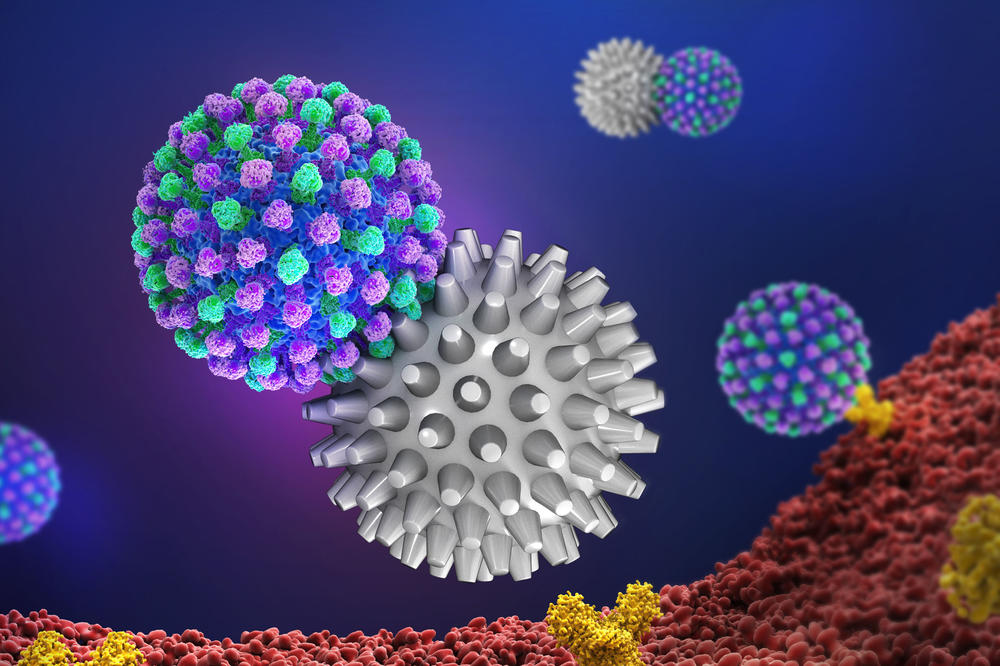Virus Shields Tailored to Fit
Multivalent virus inhibitors can prevent pathogens from infecting cells
Sep 08, 2020
The virus surface (pictured as blue and green) is prevented by the spikes on the multivalent nanoparticles (gray) from latching onto the cell membrane (red), which effectively prevents infection.
Image Credit: Freie Universität Berlin
Most people who become infected with the novel coronavirus (SARS-CoV-2) experience only mild symptoms. However, under certain conditions – if a pathogen infects cells in the lung tissue, for example – an infection can be fatal, especially for older people or those with underlying health conditions. Until an approved vaccine for Covid-19 is available, our best hope for preventing such fatalities is drugs that can lessen the severity of infection – or better yet, prevent infection and organ damage altogether.
Rainer Haag, a professor of chemistry at Freie Universität Berlin, and his team of researchers are conducting studies that build on this premise. Professor Haag leads Freie Universität’s Collaborative Research Center (CRC) 765, “Multivalency as Chemical Organization and Action Principle: New Architectures, Functions and Applications.” Recent findings from the group have now been published and indicate the medical potential behind this approach. In their research, the group was able to prevent flu viruses from using their receptors to latch onto the surface of the host cell and infect it.
Two Protective Shield Strategies
The group developed what are known as multivalent virus inhibitors. They attach themselves to the virus’s receptors, causing the virus to act as if it has latched onto the surface of a real lung tissue cell. This shields the actual cell from infection. Researchers from Freie Universität Berlin worked together with researchers at Humboldt-Universität zu Berlin and the Robert Koch Institute to develop two different ways of initiating a shield effect through inhibitors. One strategy was to apply an especially soft nanogel to the virus membrane. The gel clings to the membrane and thus shields the host cell.
The second strategy involved the use of “spike molecules” that stick up out of a pathogen’s outer surface, or envelope, like the points of a crown. The scientists applied other spiked surfaces to the virus that interlocked precisely with the virus structure. Like two pieces of a jigsaw puzzle, the spikes on the inhibitor surfaces and the spikes on the virus fitted together perfectly, creating a shield effect. Both shielding strategies resulted in a drastic reduction in the viral load (the number of cells infected by a pathogen) when inhibitors were applied that could interlock perfectly.
Looking for the Ideal Mask Material
The new inhibitor strategies will now be tested in the context of coronavirus research. “The way in which viruses infect cells by attaching themselves to the host cell surface is often very similar. The protein molecules that we find in coronaviruses have spiked surfaces much like those we find in flu viruses,” explains Rainer Haag. “You might say that we’re trying to tailor the attachment molecules to fit the SARS-CoV-2 structure.”
The multivalent virus inhibitors could potentially be used to treat patients in the form of water-soluble macromolecules for inhalation or intravenous use. But it might also be possible to integrate them in the nonwoven textiles used for medical masks. “The material used for traditional hospital masks is porous, like a coffee filter,” says Rainer Haag.
“This means that the distance between each fiber is too big to stop viruses from getting through the pores.” Larger droplets are caught by the mask, he explains, but it doesn’t stop smaller droplets. However, if the nonwoven material were to be given additional functionality with the multivalent virus inhibitors discovered by the CRC, it could offer much greater protection. Current studies are therefore testing the effect of adding virus inhibitors to different surface structures.
This text originally appeared in German on June 21, 2020, in the Tagesspiegel newspaper supplement published by Freie Universität.
Further Information
Professor Dr. Rainer Haag, Institute of Chemistry and Biochemistry, Department of Biology, Chemistry, Pharmacy, Freie Universität Berlin, Tel.: +49 30 838 52633, Email: haag@chemie.fu-berlin.de

